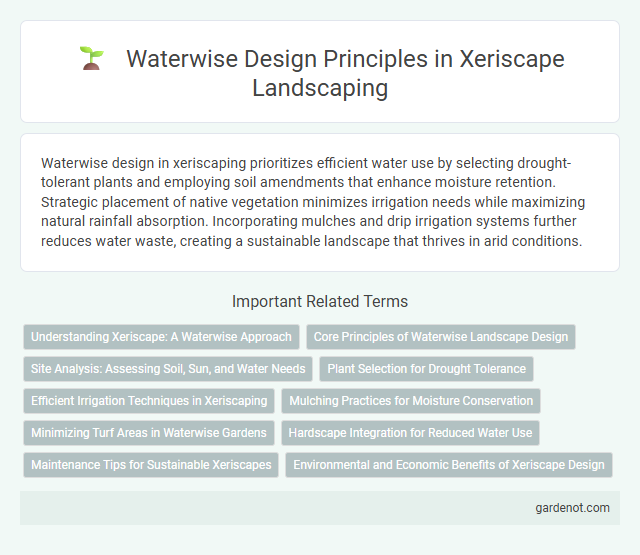Waterwise design in xeriscaping prioritizes efficient water use by selecting drought-tolerant plants and employing soil amendments that enhance moisture retention. Strategic placement of native vegetation minimizes irrigation needs while maximizing natural rainfall absorption. Incorporating mulches and drip irrigation systems further reduces water waste, creating a sustainable landscape that thrives in arid conditions.
Understanding Xeriscape: A Waterwise Approach
Xeriscape is a waterwise landscaping method designed to minimize water use through drought-resistant plants and efficient irrigation techniques. It incorporates soil improvement, mulching, and strategic plant placement to reduce evaporation and runoff. Emphasizing native and adaptive species, xeriscape ensures sustainable, low-maintenance outdoor spaces that conserve water resources effectively.
Core Principles of Waterwise Landscape Design
Waterwise landscape design emphasizes water conservation through principles such as soil improvement to enhance moisture retention, strategic plant selection with drought-tolerant species, and efficient irrigation systems like drip watering. Incorporating mulching and zoning plants according to their water needs reduces water waste and promotes sustainable landscaping. These core principles form the foundation of xeriscaping, optimizing water use while maintaining aesthetic and ecological benefits.
Site Analysis: Assessing Soil, Sun, and Water Needs
Site analysis in xeriscape design involves evaluating soil composition, sunlight exposure, and water availability to optimize water conservation. Understanding soil texture and permeability informs irrigation strategies, while assessing sun patterns guides plant selection for drought tolerance. Precise water needs assessment reduces waste by aligning landscape features with natural site conditions.
Plant Selection for Drought Tolerance
Choosing drought-tolerant plants is crucial in xeriscape waterwise design to minimize irrigation needs and promote sustainable landscaping. Native species like lavender, sage, and succulents thrive in arid conditions while conserving water resources. Incorporating deep-rooted, drought-resistant plants enhances soil moisture retention and reduces overall water consumption.
Efficient Irrigation Techniques in Xeriscaping
Efficient irrigation techniques in xeriscaping prioritize water conservation through drip irrigation, micro-sprinklers, and smart controllers that deliver precise water amounts directly to plant roots. Mulching and scheduling irrigation during cooler parts of the day reduce evaporation and runoff, maximizing water use efficiency. These waterwise design strategies significantly lower water consumption while maintaining healthy, drought-tolerant landscapes.
Mulching Practices for Moisture Conservation
Mulching practices in xeriscape waterwise design play a critical role in moisture conservation by reducing soil evaporation and regulating temperature. Organic mulches such as wood chips and bark improve soil structure and nutrient retention while suppressing weed growth that competes for water. Efficient mulching can reduce irrigation needs by up to 50%, making it a vital strategy for sustainable landscape management in arid climates.
Minimizing Turf Areas in Waterwise Gardens
Minimizing turf areas in waterwise gardens significantly reduces water consumption by replacing traditional grass with drought-tolerant plants and permeable ground covers. Xeriscape principles emphasize the use of native and adapted plant species that require minimal irrigation, enhancing landscape sustainability. Efficient water management in these designs supports ecosystem health while lowering maintenance and utility costs.
Hardscape Integration for Reduced Water Use
Hardscape integration in xeriscape design enhances water conservation by strategically incorporating permeable materials such as gravel, decomposed granite, and permeable pavers, which reduce runoff and promote groundwater recharge. Using retaining walls, patios, and walkways made from water-efficient hardscape elements minimizes the need for supplemental irrigation while creating functional outdoor spaces. Optimizing hardscape placement around drought-tolerant plantings maximizes soil moisture retention and lowers overall landscape water demand.
Maintenance Tips for Sustainable Xeriscapes
Efficient waterwise design in xeriscapes reduces irrigation needs by selecting drought-tolerant plants and implementing drip irrigation systems that deliver water directly to roots. Mulching with organic materials conserves soil moisture, suppresses weeds, and improves soil health, minimizing maintenance demands. Regular monitoring of soil moisture and pruning ensures plant vitality, promoting a sustainable and low-maintenance xeriscape environment.
Environmental and Economic Benefits of Xeriscape Design
Xeriscape design conserves water by utilizing drought-tolerant plants and efficient irrigation systems, significantly reducing outdoor water usage. This waterwise approach lowers water bills and decreases demand on municipal water supplies, resulting in substantial economic savings. Environmentally, xeriscaping enhances soil health, reduces runoff and erosion, and supports biodiversity by creating sustainable habitats with minimal resource input.
Waterwise design Infographic

 gardenot.com
gardenot.com